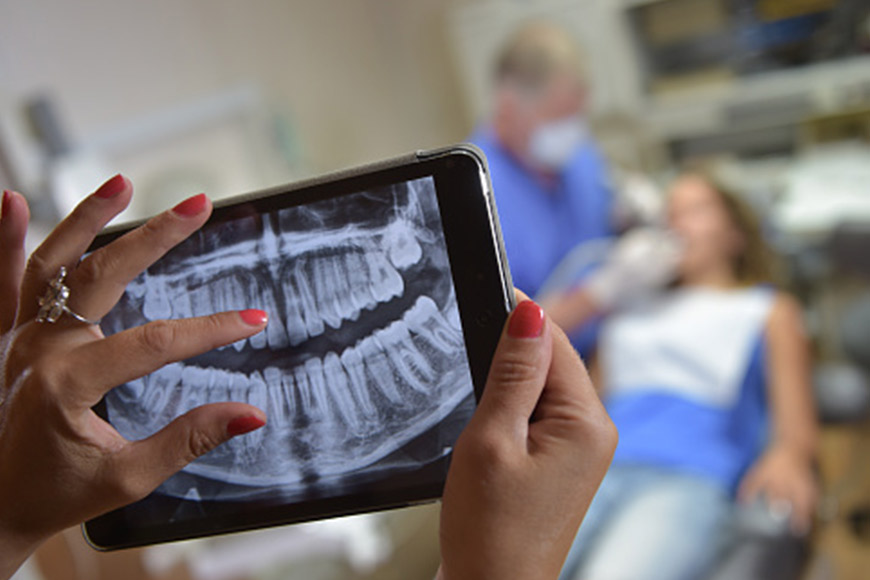How is an X-ray performed?
Dental X-rays are taken while you are sitting upright in a chair.
The dental specialist will put a lead cover over your chest and fold a thyroid collar over your neck.
An X-ray sensor or film will be placed in your mouth for the image.
Most patients do not experience any problems or inconvenience when having an X-ray. The size and location of the sensor is an important factor in how comfortable or uncomfortable you feel. The size of your mouth is also a factor because if you have a small mouth, it makes placing the sensor more difficult. Having an X-ray should never be painful, at most embarrassing or uncomfortable.

If you have a sensitive swallowing reaction, you may want to tell your dental technician ahead of time. There are things they can do to help maintain the gag reflex while the X-ray is taken. Children are particularly prone to dull reflexes and have difficulty getting dental x-rays.
X-ray Bitwing
White wings are usually taken every year (or as recommended by your dentist) to help detect cavities between your teeth as well as to check the level of the bones containing your teeth.
X-ray periapical
Often referred to as a PA, this type of X-ray takes a complete picture of the tooth from the top of the tooth (the crown) to the tip of the root. Periapical X-rays are usually taken when you have symptoms at a certain age or as a follow-up to a procedure.
Occlusal x-ray
These specialized X-rays are not used as routinely as others but can provide very valuable information. They are usually used to show the roof or floor of the mouth and to check for things like extra teeth, impacted teeth, deformities, jaw problems, and any hard growths such as tumors.
Panoramic x-ray
A panoramic x-ray is taken every 3-5 years (or whatever the dentist recommends) but it can also be taken by an orthodontist in preparation for orthodontics and an oral surgeon in preparation for surgery, such as wisdom teeth extractions.
Digital x-ray vs x-ray
Digital X-rays are starting to replace the traditional film X-rays due to their ease of use, efficiency and most importantly, the low amount of radiation needed and used. Digital X-rays are captured with a specialized sensor that sends the image directly to a computer, where it can be viewed immediately. With regular X-ray film, if the image comes out too light or too dark, you will need to retake it. With a digital x-ray, you can set the x-ray on a computer to allow for an easier reading. The dentist can also magnify certain areas from the X-ray and even create a larger image.
Concerns about radiation
There are guidelines and regulations in place in order to minimize radiation exposure. Countries often have very strict protocols, as well as inspections, to protect the safety of the public. And while we should all try to limit our exposure, dental x-ray equipment (if used properly and technicians follow all recommended guidelines) is fairly safe and uses very little radiation.
Pregnancy and dental x-rays
Research on the safety of dental X-rays during pregnancy is mixed. But the American Dental Association and the American College of Obstetricians and Gynecologists say that X-rays during pregnancy are safe and agree that delaying dental work can lead to more complex problems in the long term. Both institutions recommend that you wear a protective apron over your throat and abdomen during radiographic imaging (X-rays).
X-ray insurance
Most dental insurance plans cover routine dental X-rays along with a routine dental exam. Every dental plan is different, so you should check with your insurance provider and/or HR representative for details about your specific plan.
Recommended frequency of dental x-rays
The U.S. Food and Drug Administration have developed the following guidelines for performing dental X-rays during a routine dental visit.
For a child with no clinical caries and no risk of caries, the hind wings are recommended to be used every 1-2 years.
An adult with no obvious clinical caries and no increased risk should receive hind wings every 2-3 years.
For children with obvious clinical caries or at increased risk of caries, hind wings are recommended every 6-12 months.
Adults with an increased risk of dental caries, obvious clinical caries, general dental disease, or a history of extensive dental treatment should have hind wings every 6-18 months.

